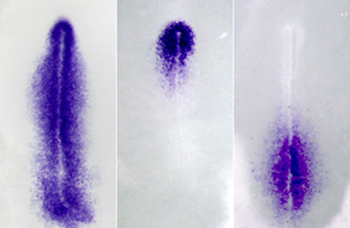| RIKEN Center for Developmental Biology (CDB) 2-2-3 Minatojima minamimachi, Chuo-ku, Kobe 650-0047, Japan |
July 28, 2010 – Of the three germ layers, the mesoderm is the source of a broad range of cell types, from muscle, bone and cartilage, to the reproductive system. In two major amniote groups (birds and mammals) the mesoderm arises from the ectoderm in the form of a structure known as the primitive streak. The cells in this transitory strip of mesodermal precursors are guided by positional cues that roughly translate starting points along the anterior-posterior axis of the streak, to tissue destinations along the dorsal-ventral axis of the embryo. Typically, cells from anterior sites in the primitive streak tend to give rise to dorsal structures, while more posterior streak cells contribute to ventral tissue types. The molecular underpinnings of this guidance system, however, have yet to be comprehensively studied.
Now, Cantas Alev and colleagues in the Laboratory for Early Embryogenesis (Guojun Sheng, Team Leader), in collaboration with the members of the Laboratories for Systems Biology and Stem cell Biology have surveyed the transcriptomic landscape of the primitive streak using genomic arrays, and developed a finer understanding of the regulation of the dorsal-ventral gradient in the developing mesoderm. Published in the journal Development, this study of events in the early chick embryogenesis provides a valuable resource for the study of tissue patterning in amniotes. Using more than 250 embryos collected at the full primitive streak stage (HH4), Alev began by dissecting out a rectangular section containing the streak from each, and subdividing it into four equal parts along its A-P axis. Next, using a commercially available genome array of around 22,000 unique genes, they tested the segments for differences in the expression of individual genes. While they found that close to 40% of the entire chicken genome is expressed across the entire streak, they did identify a number of genes whose expression levels varied from segment to segment. The team analyzed all genes that could be assigned a Gene Ontology classification, which is a method for categorizing genetic functional activity. Alev found that around 14% of the expressed transcripts could be grouped into six clusters defined by the expression in various combinations of segments, such as [1,0,0,0] or [0,0,0,1], representing either dorsal-to-ventral (Group A) or ventral-to-dorsal (Group D) asymmetric expression. While many Gene Ontology categories were evenly represented across both groups, the team did find that genes involved in transcriptional regulation and receptor-mediated signaling showed biased expression, with transcriptional regulators expressed more in Group D, and signaling genes more in Group A. In their analysis, the authors focused particularly on three major developmental pathways - Wnt, TGFβ/BMP, and FGF - but found that for the most part their core components were not differentially expressed. However, regulators of these pathways frequently did show either dorsal or ventral distributions. The total picture that arises from this set of findings is of a complex, multi-tiered network of genes interacting with and regulating the activity of key pathways involved in setting up the D-V axis. "To embryologists and stem cell biologists alike, the primitive streak is a fascinating structure that defies simplification," says Sheng. "Our study offers a resource for achieving a better understanding of its molecular complexity in vivo. We're hopeful that this understanding can also help achieve efficient and targeted mesoderm lineage differentiation in translational research." |
||||
|
||||
 |
| Copyright (C) CENTER FOR DEVELOPMENTAL BIOLOGY All rights reserved. |
